ALFRED KUBIN (Litomerice 1877 - 1959 Wernstein am Inn) Age, 1947
Lot 97
Categories
Estimate:
EUR€2,000 - EUR€3,000
$2,083.33 - $3,125
Absentee vs Live bid
Two ways to bid:
- Leave a max absentee bid and the platform will bid on your behalf up to your maximum bid during the live auction.
- Bid live during the auction and your bids will be submitted real-time to the auctioneer.
Bid Increments
| Price | Bid Increment |
|---|---|
| EUR€0 | EUR€10 |
| EUR€100 | EUR€50 |
| EUR€700 | EUR€100 |
| EUR€1,000 | EUR€200 |
| EUR€3,000 | EUR€300 |
| EUR€3,600 | EUR€400 |
| EUR€4,000 | EUR€500 |
| EUR€7,000 | EUR€1,000 |
| EUR€16,000 | EUR€2,000 |
| EUR€30,000 | EUR€3,000 |
| EUR€36,000 | EUR€4,000 |
| EUR€40,000 | EUR€5,000 |
About Auction
By Widder Auctions
May 19, 2022
Set Reminder
2022-05-19 11:00:00
2022-05-19 11:00:00
America/New_York
Bidsquare
Bidsquare : Masterpieces
https://www.bidsquare.com/auctions/widder-auctions/masterpieces-9287
Masterpieces of classical modernism by Austrian and international artists coming up for auction in Vienna on May 19th Widder Auctions office@widderauktionen.com
Masterpieces of classical modernism by Austrian and international artists coming up for auction in Vienna on May 19th Widder Auctions office@widderauktionen.com
- Lot Description
ALFRED KUBIN*
(Litomerice 1877 - 1959 Wernstein am Inn)
Age, 1947
indian ink/paper 40 x 29,5 cm
signed A Kubin, dated 47 and titled Alter (Age)
Provenance: private property Vienna
ESTIMATE °€ 2.000 - 3.000
Austrian painter, graphic artist and book illustrator of the 20th century. First worked as a photographer, from 1898 in Munich at the private painting school of Ludwig Schmid-Reutte. 1902 first exhibition in Berlin. 1903 publication of the Weber folder, made possible by the sponsors Max Dauthendey and Hans von Weber. From 1906 based in Wernstein am Inn at Zwickledt Castle. Mainly active as a draftsman, created single sheets and series that appeared as portfolios and book illustrations. 1912 and 1913 Participation in Blue Rider exhibitions. Lifelong friendship with Fritz von Herzmanovsky. From 1912 illustrations for Simplicissimus. Works characterized by uncanny and spooky elements, dealing with works by James Ensor, Max Klinger, Edvard Munch and Odilon Redon. Parallels to E.T.A. Hoffmanns, F. Dostojewskijs and E.A. Poe. Mainly ink drawings, often with demonic, nightmarish scenes and a penchant for the grotesque. Also dealing with historical topics or humorous depiction of human characteristics.
Alfred Kubin had a troubled childhood. The mother died early and the family moved frequently. Unsure of which vocation he should follow, he first completed an apprenticeship as a photographer. In 1898 Kubin went to Munich, studied at the academy, but soon continued to educate himself. Encountering the works of Ensor, Klinger, Munch and Redon was decisive for the young Kubin. His first exhibition in Berlin in 1902 caused a lack of understanding. However, important sponsors turned up in the form of the poet Max Dauthendey and the collector and publisher Hans von Weber. The publication of the Weber portfolio in 1903 brought about the breakthrough. Already in the spring of that year, Kubin was represented in the Secession exhibition. He met Fritz von Herzmanovsky, with whom he had a lifelong friendship, and established contacts with important Expressionist artists. In 1912 he began to work for the newly founded "Simplicissimus". During the First World War, Kubin dealt with psychoanalysis and philosophy. In 1921 he had his first retrospective. He produced a large number of lithographs and was also active as a writer. Countless works in magazines and illustrations for writers followed. Kubin's oeuvre is full of surprising pictorial ideas from his almost inexhaustible world of life and dreams - full of secrets and abysses, bizarreness and banality, whereby many of his drawings elude any conventional interpretation. Perhaps this is one of the reasons why Kubin's cosmos of images is mostly categorized as pandemonium. This overly one-sided reading wrongly overshadowed what was cheerful, humorous and all too human in Alfred Kubin's graphic work. It is precisely his subtle caricature of bourgeois Phaeacism and the all too ostentatious display of enjoyment. Kubin also works again and again on proverbs and concepts such as the "old horse", he also titled a trotting down and emaciated old nag with "age". The old saying “Once an old horse gets going, it can no longer be stopped” proves to be appropriate here.
PLEASE NOTE:
The purchase price consists of the highest bid plus the buyer's premium, sales tax and, if applicable, the fee of artists resale rights. In the case of normal taxation (marked ° in the catalog), a premium of 24% is added to the highest bid. The mandatory sales tax of 13% is added to the sum of the highest bid and the buyer's premium. The buyer's premium amounts to 28% in case of differential taxation. The sales tax is included in the differential taxation. - Shipping Info
-
Shipping
We will send you the invoice shortly after the auction. As soon as we have recieved the amount, the art can be picked up at Johannesgasse 9-13, 1010 Vienna. Please note that the buyer is responsible for pick-up and shipping of the lot.
Should you wish to ship your items, please contact: Mailboxes Email: oper@mbe-co.at Tel: 01 5128855
Please note that storage fees may apply, should the pieces not be picked up within 14 days after invoicing for domestic and 28 days for international transportation.
Our team will be happy to assist you with any further information at office@widderauktionen.com or at 0043 676 555 66 10.
-
- Buyer's Premium



 EUR
EUR CAD
CAD AUD
AUD GBP
GBP MXN
MXN HKD
HKD CNY
CNY MYR
MYR SEK
SEK SGD
SGD CHF
CHF THB
THB












